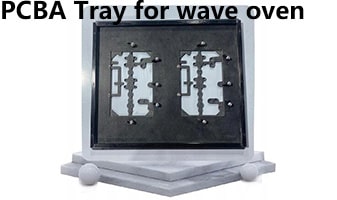PCBA Tray for wave oven
Tray, a tooling fixture to protect the PCB and components during wave soldering process, avoid PCB deformation, and assist in supporting and positioning. Which is suitable for PTH components.

What is the function of wave soldering tray? The main points are as follows:
- Solve the bad phenomena such as component floating height, skew, andinsufficient tin.
- Prevent overflow tin from contaminating the PCB and prevent PCB bending and deformation.
- Irregular-shaped PCB must use the tray when via the wave soldering oven.
- Avoid contamination of golden fingers.
What kind of PCB designs require the use of wave soldering trays/fixtures?
- Double-sided PCB assembly: Especially when one side of the PCB has been completed SMT soldering, and the other side needs to be through the wave soldering to solder through-hole components (such as DIP packages). the use of fixtures can effectively protect the side that has already been soldered from damage, and to ensure that the components on the soldered side are properly aligned and supported.
- Large or Heavy Components: For PCBs with large or heavy components mounted on them, the use of fixtures prevents components from shifting or falling off due to their own weight or vibration during the soldering process.
- Sensitive component protection: PCB design containing sensitive components (such as fragile ceramic capacitors, crystal oscillators, etc.), fixtures can be designed with a specific protection structure to avoid thermal shock or physical damage to these components during the soldering process.
- Improve productivity and yield: In a mass production environment, fixtures ensure consistency and accuracy of soldering, reducing human error and improving productivity and product quality.
- Special shapes or sizes of PCBs: Non-standard shapes or sizes of PCBs may be difficult to pass directly through the wave soldering machine, and fixtures can be adapted to ensure that these PCBs pass smoothly through the soldering process.
- Reduce or avoid PCB deformation: Larger PCBs are particularly susceptible to deformation during heating and cooling cycles. Fixtures help reduce this deformation by evenly distributing pressure and providing additional support.







